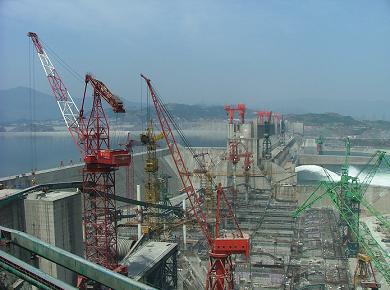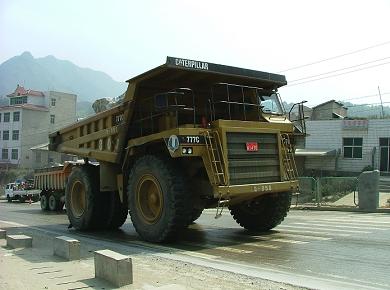The Three Gorges Project
At the moment on the Jangzhe River the biggest hydroelectric power plant in the world is under construction. After the construction it will supply more energy than the powerplant in Iguazy which I was visiting on my Southamerica trip. So for me it was a must to see the Chinese version of a big river hydroelelectric power plant!

The "Three Gorges Project" is not only the biggest river project in the world but also the most controversial construction of China. Though the planning startet in the 50's the national people's congress decided the realisation in 1992. The Jangshe River is with the length of 6300 km the second largest river in the world. Unfortunatly heavy rainfalls bring big rises of the water level around every ten years which is a big danger for the high populated region. Due to floods 1931 and 1935 each time around 150,000 and 1954 over 35,000 people lost their life.
Other problems are reefs and rocks under the water, vortexes and shallows which are very dangerous for the ship navigation. A embankment dam would bring not only a rise of the water level but also due to the wider river it could serve for more navigation which could be an important step for economical and industrial development along the Jangzhe River. Because of the much easier transport way a lot of regions would be opened up
for the rest of China and would be economicaly much more attractiv.
Additionaly the water masses could be used for the production of cheap electricity for central and eastern provinces of China without a good access to electric power and could replace the annual combustion of 40-50 million tons of coal with clean and renewable energy.
So the reasons for the construction of the dam consist of three points:
1. Energy production
2. Flood control
3. Open up the Chinese middle land with navigation
As you can see on the picture one half of the dam is already finished. But at the other side the constructions are still going on untiringly.

The dam is 185 metres high and 2.3 km wide. After the completion of the construction the water will be damed up and will fall down 115 metres and activate 26 turbines each with 700 MW which gives a total of 18,200 MW, what is 18 times more than a normal nuclear power plant. The produced energy will provide 34% of China's energy demands. At the beginning the estimated costs of the whole project was around 12 billion Euro (around 15 billion US-Dollars), but experts expect a end sum which is three to five times bigger.
Together with a guide I was allowed to enter the construction site to see the big dam works.


Here you see the installation of a big tube which channels the water to the turbine.

The diameter of the tube is about 12 metres. Here I show you a closer picture. In the front you see workers who you can compare with the size of the tube. It's very big, isn't it?

The constructions started in 1993 and will be finished like estimated in 2009. The water is already damed up now and is already used for the energy production on the completed site.
But on the construction side the works are going on very actively. They lay the iron reinforcement and cover it with concrete and drive around stones and bulk material. You have to be quite careful not to be ridden over by one of the huge trucks...

Due to the rise of the water level the water is damed back around 600 km and will submerge numerous villages and cities and force around 1.8 million people to move. Here you see the headwater of the river.

And the resettlement are in fact again and again a critic point of the big project. Since the foundation of the Peoples Republic of China about 10 million people were resettled because of the construction of dams. In the former projects the people didn't receive any help from the government and alot of them were in economical misery because of the missing help. Especially problematic are the resettlements of the farmers. Because there is no refund for the land available they have to search for new posibilities for the income.
Even though the Chinese government supports the locals and searches for solutions the international human rights organisations still complain because after peaceful demonstrations the Chinese government imprisoned some people who are still in jail without any hope for a fair process.
Due to the rise of the water level of the Jangzhe the flow velocity will decrease and because of this the self cleaning force of the river will be reduced. Because of this a lot of garbage dump and industrial contaminated soils must be disposed and also the water pollution has to be reduced. Nowadays around one billion cubic metres non-clarified water (status 1998) flows annualy into the Jangzhe River. And still not all of this problems are solved yet.
This and other problems and concerns are the critic points of the project. But on the homepage of the Chinese Embassy in Germany I found the following statement:
Are there any reverses of the project? You will not hear any complaints from the Chinese experts.
Andy
17.06.04,Yichang, China